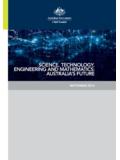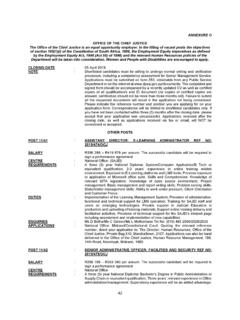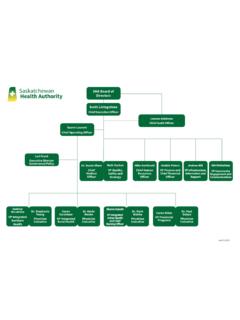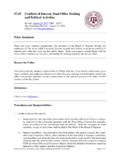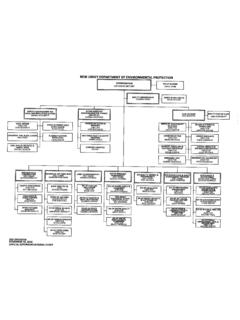Transcription of Hydrogen for Australia's future - chiefscientist.gov.au
1 Hydrogen for Australia's future A briefing paper for the COAG Energy Council Prepared by the Hydrogen Strategy Group August 2018. Copyright Commonwealth of Australia, 2018. The Hydrogen for Australia's future is licensed by the Commonwealth of Australia for use under a Creative Commons Attribution International licence with the exception of the Coat of Arms of the Commonwealth of Australia, the logo of the agency responsible for publishing the report, content supplied by third parties, and any images depicting people. For licence conditions see: This report should be attributed as Hydrogen for Australia's future , Commonwealth of Australia, 2018'.
2 The Commonwealth of Australia has made all reasonable efforts to identify content supplied by third parties using the following format Copyright, [name of third party]'. Disclaimer The views and opinions expressed in this publication are those of the authors and do not necessarily reflect those of the Australian Government or the Minister for the Environment and Energy. While reasonable efforts have been made to ensure that the contents of this publication are factually correct, the Commonwealth does not accept responsibility for the accuracy or completeness of the contents, and shall not be liable for any loss or damage that may be occasioned directly or indirectly through the use of, or reliance on, the contents of this publication.
3 Hydrogen Strategy Group H2. Vision Statement Our vision is a future in which Hydrogen provides economic benefits to Australia through export revenue and new industries and jobs, supports the transition to low emissions energy across electricity, heating, transport and industry, improves energy system resilience and increases consumer choice. The Key Opportunity To capture the Hydrogen export market and associated benefits in the domestic economy. i Hydrogen Strategy Group Taskforce Dr Alan Finkel (chair) Dr Patrick Hartley (lead). chief Scientist of Australia CSIRO Energy Professor Rose Amal Dr Tom Campey (deputy lead). The University of New South Wales Australian Renewable Energy Agency Brad Archer Dr Nick Burke Department of the Environment and Energy CSIRO Energy Professor Peta Ashworth Craig de Laine The University of Queensland Australian Gas Infrastructure Group Andrew Dillon Anthony Dewar Energy Networks Australia Department of the Environment and Energy Ivor Frischknecht Dr Lesley Dowling Australian Renewable Energy Agency Department of the Environment and Energy Martin Hablutzel Ashley Muldrew Siemens Australian Gas Infrastructure Group Claire Johnson Clinton Porteous Hydrogen Mobility Australia Office of the chief Scientist Mike Lawson
4 Alison Reeve Department of Industry, Innovation and Science Department of the Environment and Energy Dr Peter Mayfield Karl Rodrigues CSIRO CSIRO Energy Ben Wilson Dr Charlotte Rouse Australian Gas Infrastructure Group Australian Renewable Energy Agency Tim Wallace Independent editorial consultant ii Hydrogen for Australia's future chief Scientist 10 August 2018. The Hon. Josh Frydenberg MP. Commonwealth Minister for Environment and Energy and COAG Energy Council Ministers Dear Ministers, The long-held dream of meeting energy needs with clean Hydrogen is becoming a reality. There are three drivers: 1. Energy export. Nations like Japan and South Korea that import most of their energy in the form of coal, oil and natural gas need cleaner energy to meet their CO2 emissions reduction targets.
5 Clean Hydrogen is ideal. Japan has already declared it will be a large-scale Hydrogen user. As yet, there are no large-scale exporters. This is a significant opportunity for Australia, given our ample renewable energy and convertible fossil-fuel reserves. 2. Domestic economy. Hydrogen can heat our buildings, power our vehicles and supply our industrial processes. These applications represent opportunities to expand manufacturing and generate spillover innovation and jobs while lowering our CO2 emissions. 3. Energy system resilience. Hydrogen production from electricity and water is a flexible load that can respond rapidly to variations in electricity production and can contribute to frequency control in the electricity grid.
6 Some of the Hydrogen can be used, like a battery, to store electrical energy, while domestic utilisation of Hydrogen will reduce reliance on imported fuels. I ask myself why now? given that the idea of a Hydrogen economy has been seriously and frequently proposed since 1972. The answer is Japan's commitment to be a large-scale enduring customer, and the hundredfold reduction in the price of solar electricity in the past four decades. Safety is paramount. The benefits to our domestic economy will only be realised by a wholehearted commitment to safety in all aspects of operation. Hydrogen produced from fossil fuels (but without carbon capture and storage) has been used for many decades for fertiliser production and oil refining, and has an exemplary safety record.
7 There is every reason to think this safety record can be preserved as we scale up the reach of Hydrogen into buildings and vehicles, as long as we commit to safety first and foremost in all that we do. Reducing the cost of producing Hydrogen is the major challenge for Australia to position itself to be a major exporter of Hydrogen , complementing our success in the LNG market. Japan has set targets for the landed import price in today's dollars of A$33/GJ in 2030 and A$22/GJ in the longer term. To reach these targets requires investing in research, development and deployment. Industry is investing but is held back by the chicken-and-egg problem.
8 Elements such as electricity generation, carbon sequestration, pipelines, electrolysers, refuelling stations and regulations depend on progress in the others. The federal, state and territory governments can provide the leadership to help these interdependent players make collective progress. The Hydrogen Strategy Group was formed by experts who see the opportunities for Hydrogen in our future economy, subject to development of the policies, technologies and infrastructure needed to safely and economically foster this new industry. Ministers, I take this opportunity to thank you for inviting the Hydrogen Strategy Group to present this report.
9 Alan Finkel Chair, Hydrogen Strategy Group iii Contents 1 5. Why Hydrogen ?..5. Hydrogen for Hydrogen for the domestic Hydrogen for energy system Why now?..7. Why Australia?..10. Australia's competitive Opportunities for states and Economic and innovation Consumer benefits ..13. 2 Hydrogen : a Hydrogen Hydrogen production using fossil Hydrogen production using renewable Hydrogen production from Hydrogen production costs, efficiencies and Hydrogen storage and Pressurised and liquefied Chemical Gas pipelines and Transport in liquid Safety considerations for storage and distribution ..22. Some properties of Hydrogen ..23. 3 The Hydrogen 25.
10 A new export Potential scale of Hydrogen Export supply chain Opportunities for the domestic Hydrogen for Hydrogen as an industrial A resilient energy Hydrogen as a flexible Hydrogen for dispatchable Hydrogen for fuel iv Hydrogen for Australia's future 4 Capturing the opportunity: the role of Community attitudes and expectations of 41. Commissioning Developing a national Positioning Australia to capture the Hydrogen export Enabling progressive Hydrogen use in domestic gas Establishing frameworks for Hydrogen Evaluating contribution to energy Facilitating adoption in industrial Supporting research, development, demonstration and pre-commercial deployment.

